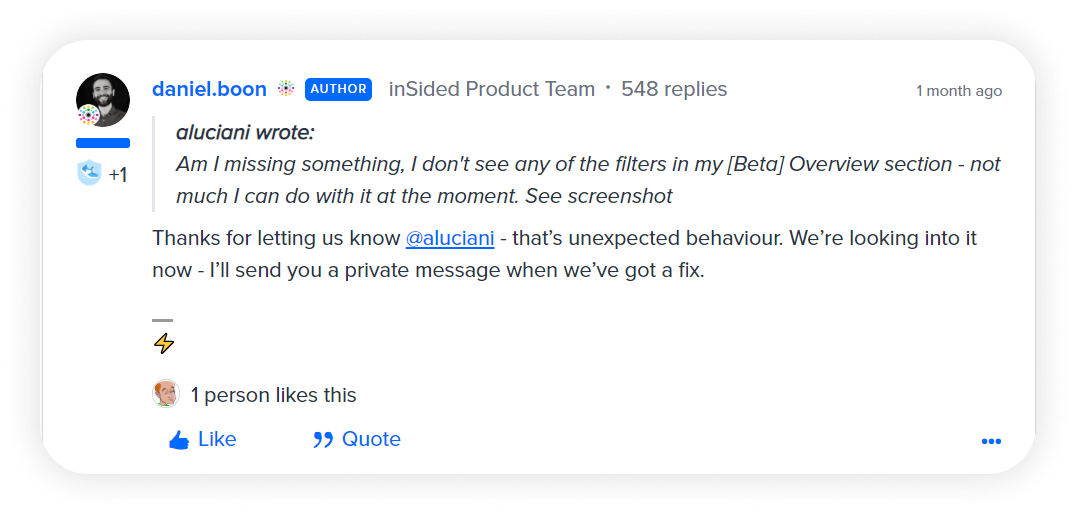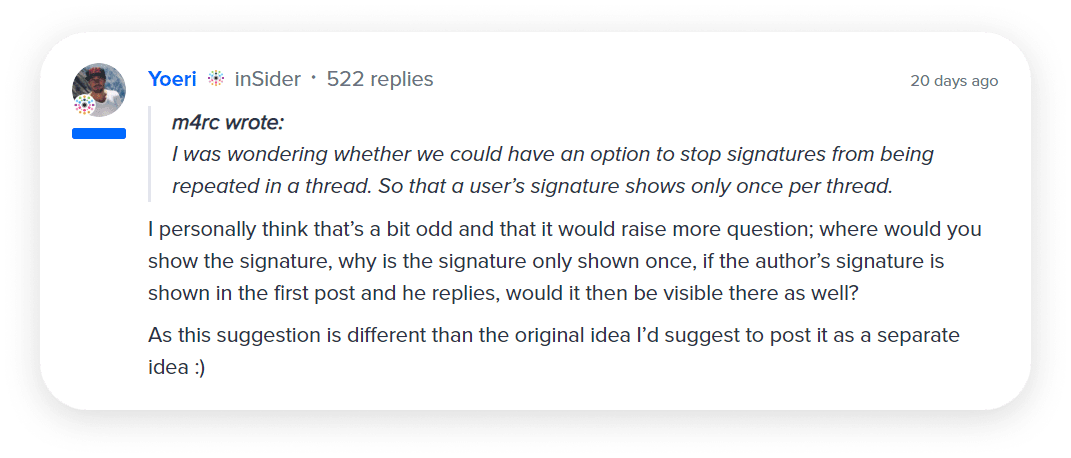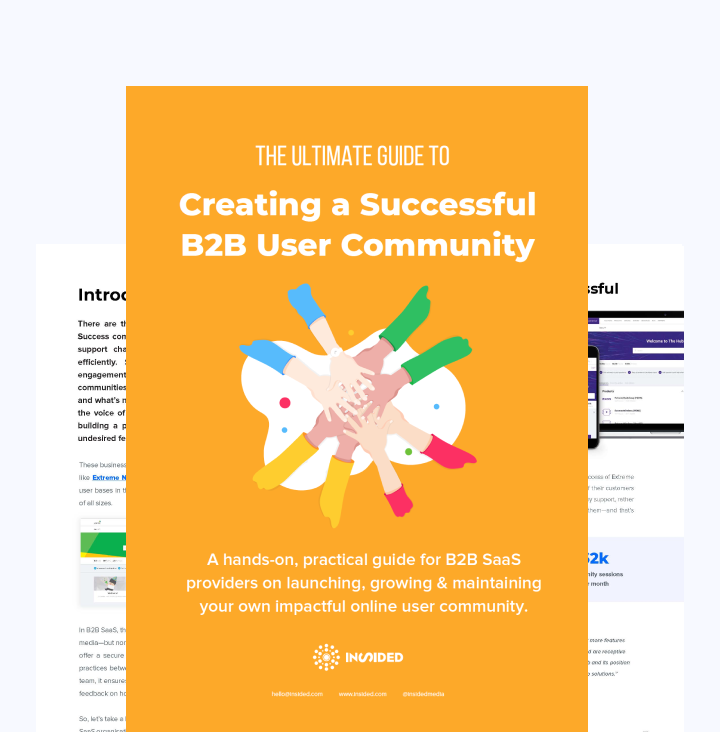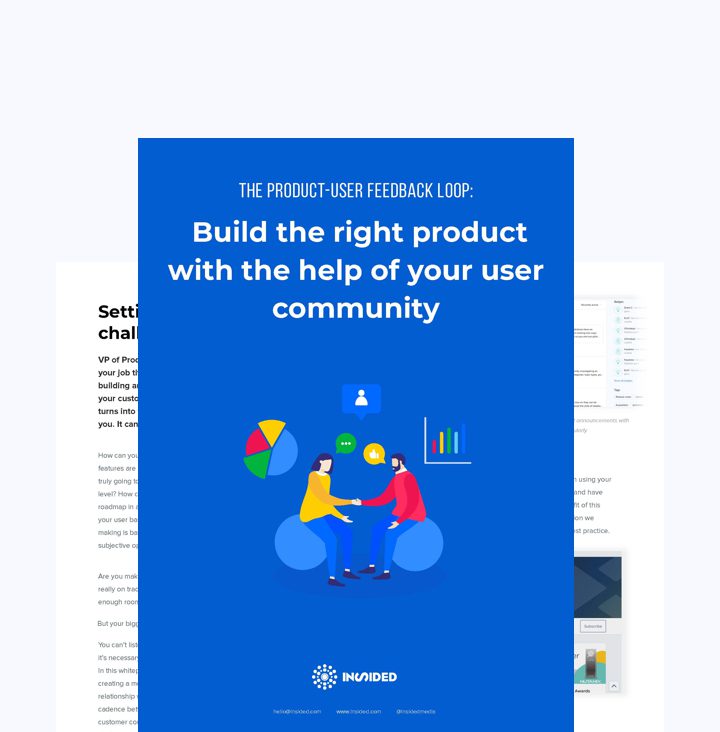Originally published on inSided.com on July 29, 2020.
“Do you have any advice for Community Managers that run into negative sentiment or negative feedback?”
– everyone
It’s an age-old question in the community world, really. Time and time again we get asked this, or hear worries from companies looking into an Online Community Platform. Companies often don’t realize that there no longer is a way to hide from negative feedback—if you’re not supplying your users with an outlet, they will find one. So what’s the main issue?
The company brand
More often than not, companies are worried that negative sentiment, feedback or even criticism after a new release can damage a brand, or the outside world’s perception of said brand.
And that’s understandable right?
Customer feedback, social proof and social reach have become decisive factors when it comes to selecting or comparing software. Thus leading to people wanting to protect themselves and their brand; steering clear from situations that even remotely feel uncomfortable.
While it’s perfectly understandable, it’s also, however, incredibly wrong.
Asking for and listening to feedback is one of the most important things you can do for your brand, and proactively providing your customers and end-users with a platform to do so allows you to own and take the lead on the discussion. We’re not saying it’s easy, don’t get us wrong. Dealing with negative feedback can be very challenging at times, but we are here to argue that facing it head on and dealing with it will ALWAYS outweigh ignoring the feedback or simply not asking.
Before we get into that further, first things first. What is negative feedback?
There are a few different types of negative feedback:
1.Feedback on product and brand
Feedback about a negative experience with, for example, your brand, support department, product or website
This is probably the most common feedback you’re going to get. Someone had a bad experience with an employee, can’t find something whilst using your product, or just had different expectations altogether. With this type of customer feedback it’s most important to get to the root cause as quickly as possible:
- What caused their bad experience and why?
- Does it happen more often / to other users?
- Are you already working on a solution?
You will want to be as transparent as possible, and explain why this has happened. This usually puts the experience into context—turning negativity in a ‘regular’ conversation about how it’s going to be solved. You’ll find that users quickly turn from ‘openly critical’ to ‘open to a conversation’ as they have the feeling they’re being heard and you are being honest.

Feedback by a group of users missing a feature, or certain aspects of the product
Look, it’s 100% normal that feature requests will outweigh your ability to pick them up and deliver on them. It’s unrealistic to expect that 100% of product feature requests will be realized—that’s just not how it works.
It IS however expected to communicate about this clearly. And not just by saying ‘no’ to every request, but also highlighting why.
- Why won’t the request be implemented?
- What are you considering instead?
- Or if you’re considering the request, when do you expect it to be delivered realistically?
- Is it in the near future or on a roadmap that’s a mile away from delivery?
What often helps is getting the people or team(s) that are actually responsible for this process, or the decision makers involved, and able to communicate to the community. You could even get Marketing and PR involved if it’s a delicate issue and you’re struggling to find the right words.

Customer Reviews
Often, you asked, they answered—but sometimes customers leave reviews that are completely unexpected out of frustration. Reviews can encompass anything from your product, service, the value they gained by using your solution (or not!) or it could be a generic negative rant about how they’re unhappy with your company. Let’s hope they’re not close to their renewal moment—yikes!
It’s important to offer time and space to secure customer reviews, as this is the main way you can improve. But research also states that 70% of prospects actively look for reviews before making a purchase. Get these right, and the whole process around feedback right actually impacts your bottom line!
2. Customer satisfaction feedback
Feedback on moderation actions
Any good community has a set of rules aimed at steering the communal discussions and making sure everyone feels safe and included. These rules, unfortunately, will sometimes be broken.
If you’ve moderated a topic and, for example, removed a post by a user that was not contributing to a valuable discussion, you’re bound to get some feedback from that user being unhappy about it. Users will ask for proof of their actually breaking the rules—maybe even quoting them back to you—or will question whether or not your actions were justified.
It’s perfectly fine to be honest with them in these cases, and provide them with that information. Send them the specific rule that was broken, include how they broke it and even consider linking them to your ToS entirely. This helps provide clarity around the issue, and you can stop engaging in a discussion afterwards.
One important thing! Don’t discuss OTHER moderators’ actions in public with users. It’s important to get rid of those discussions right away. Having open discussions like that might undermine the authority of you and your colleagues, it’s likely you might even want to specify this in the ToS from the get-go.
3. Barely even feedback at all
Trolling & spam
Not really feedback, but both spam and trolling can truly disrupt the natural flow of a community platform. Unfortunately the nature of these activities also make it a constant battle. It never truly ends, and you should always be on your guard.
There are a few things you can do to limit the effects of spam and trolling:
Spam filters: Any Community Platform worth its salt has a spam filter running, figuring out which new registrations are actual users looking to engage and which are bots looking to disrupt. They will never catch everything, but save you a TON of time cleaning up when they work well.

Enforcing posting limits: for new accounts, or limiting registrations for a period of time. Obviously this can feel strange when using a community to actually stimulate engagement, but it can be effective to get a community back on track.
If nothing else works: Registration Approval. Less effective for bigger communities, but manually approving new registrations can save you a lot of headaches.
General tips for dealing with online customer feedback
Spend most of your time on long, public replies. Private messages can be short and sweet. If you’re going public with something, you need to be sure to cover your bases and make sure everyone understands. It’s also perfectly fine to redirect a private conversation to the public community when you feel it could be beneficial for everyone.
Always show empathy. Users having problems need to feel understood. Don’t just say you’re sorry, but say that you would totally respond in the same way if you were in their situation.
Share feedback internally. It’s good for other teams to be aware of what’s going on in the customer community—even if there’s no direct solution or if the team you are sharing it with can’t actually do something about it.
And last but not least, you always need to be there for your users. Even if someone’s constantly being negative, there will be a reason for their behaviour. It’s your responsibility to figure out what that is, and how to turn it around.
You’re a mediator between your company and the customer, and need to act with both parties’ interests in mind. On the one hand, you’re helping your colleagues and company improve their products and services, and on the other hand you’re educating your users and helping them achieve more value from your product(s).
Luckily, most negative feedback can be resolved by simply having an open mind and listening to what your users have to say. As soon as users feel recognized, their tone of voice will change dramatically. Try it. As much as it sometimes feels like you’re spending too much time on a single case, remember that your response in that situation is visible to your entire community—maybe even your prospects—and tells them your brand is taking them seriously.
For more information on customer feedback and closing the product feedback loop, check out our guide.



